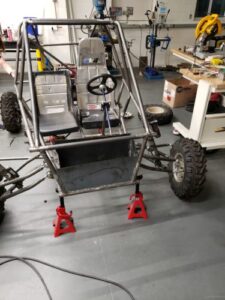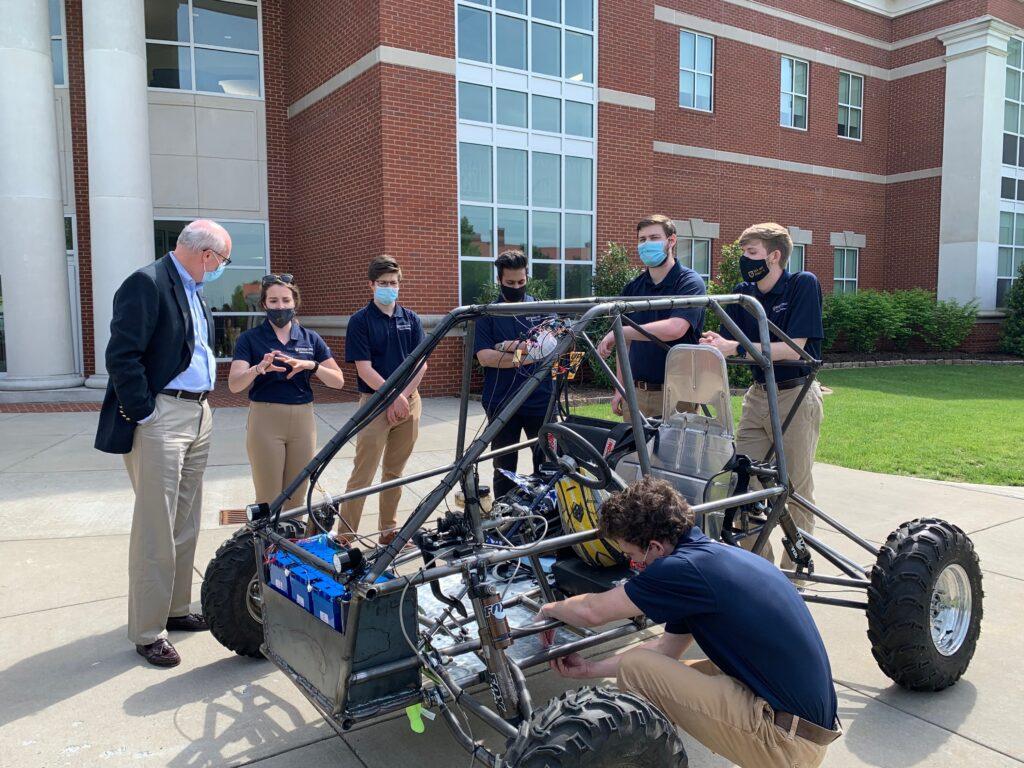Ben Overby
Staff Writer
boverby2@murraystate.edu
A team of six students in Senior Design I and II spent the fall 2020 and spring 2021 semesters designing and building the E-vehicle, a two-person off-road vehicle with a 17-horsepower electric engine.
School of Engineering Chair Danny Claiborne said he finds and allocates funds for all senior design projects. With other faculty members, Claiborne also approves funds for projects based on seniors’ proposals.
“The School of Engineering has been successful in building several types of vehicles in the past,” Claiborne said. “The Engineering Physics students have participated in a gas-operated Baja buggy for many years. The Electromechanical Engineering Technology students have participated in a hydraulic bicycle competition and have won that competition at the national level two times. This is the first e-vehicle attempted by the School of Engineering, and I am very excited about the success of the senior design team and the engineering faculty.”
Claiborne said the funds for this project were provided by a University foundation account established by Johny Russell who was one of the engineers on the original NASA Moon Buggy. Other state-allocated funds provided by the University also go towards these projects, but the Russell funds were needed to complete the project due to its high costs.
Claiborne said the e-vehicle is a perfect example of the learning opportunities in the engineering program.

“During the last semester of the engineering students, many hours are dedicated to their senior design projects,” Claiborne said. “We are very proud of our seniors, particularly during a very challenging time, to successfully complete a project of this magnitude and impact.”
Senior engineering physics major Tyler Whetstone said all of the design and analysis work was completed in the fall semester while the team built the vehicle during the spring semester.
“Since we have 3 mechanical-focused people and 3 electrical-focused people, we divided the car into subsystems accordingly; for example: chassis, suspension, motor, etc.,” Whetstone said. “We each had different ways of coming to our final designs, but the entire team has a group design report that we each contributed to according to our portion of the project.”
Whetstone said part of the proposal process wwas giving an estimated budget for the project to be approved by Murray State. The students purchased all of their materials through the approved budget.
“All online purchases are ordered through the engineering department’s amazing administrative assistant, and all in-person purchases are done with the card given by the same,” Whetstone said. “Our team had to designate a “purchaser” for the project, that being the only person who sends requests and actually has to be there for purchases. That person was me, so I did that and kept track of our budget throughout the semester.”
Whetstone said the most difficult aspect of the project was getting all six subsystems of the vehicle to fit together perfectly. He said although the team ran into a lot of unforeseen issues while building the vehicle, they were always able to work through it and ended up with a project they are proud of.
“It’s a really awesome project that I am glad I got to be a part of,” Whetstone said. “I think electric vehicles are definitely the way of the future, although how soon I don’t know, so getting to build one was really great. Our vehicle is really tough, even if it isn’t perfect.”
Whetstone said the vehicle was a great legacy to leave behind at Murray State.
Senior engineering physics major Jackson Arnold said teamwork between the students working on the project was vital to its success. He said it took a lot of time and dedication from all members of the group to complete the vehicle.
“It was a group effort to build the vehicle for sure,” Arnold said. “No individual built it and we all participated in cutting tubing, welding the chassis, wiring components, and troubleshooting everything along the way.”
Every time the group hit a huge roadblock, Arnold said they fixed it there or came back to it. Arnold said he was proud to be a part of the project to show that the technology behind electric cars is something students can comprehend.
“We had some electronics problems and stayed late to sort everything out and check wires and at the end of the night it was driving,” Arnold said. “There were a lot of hard parts that came with this project, but nothing that ever made us stop fabrication completely.”
Senior engineering physics majorShariq Fayaz Lnu said he worked on the brakes for the vehicle, but everyone worked together for most of the project.
Lnu said none of the members had any experience in welding or bending of the pipes. Hooking up the steering and the test drive were the most memorable parts since the members could see their car finally work.
“Out of everything, the most memorable part thing I’d take from this is the amount of experience I gained working on the car, and I was really happy to spend time with my team,” Lnu said. “There were so many unforgettable moments made with the team, which I will never forget and cherish for the rest of my life.”




























































































